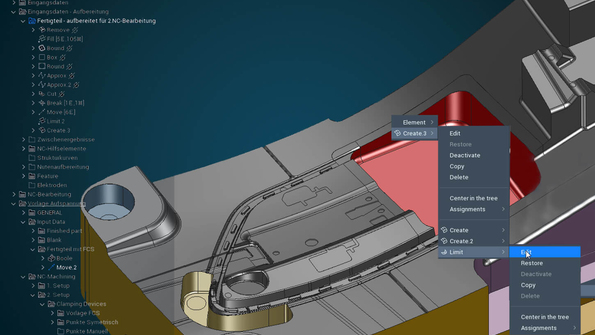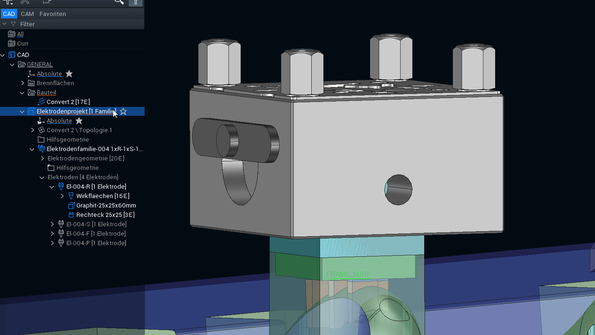Call us:
+1-248-524-0430
Title
Description
-
Software
-
CAM software
- Tebis Automill
- CNC programming
- CNC automation
- CNC simulator
- Multiple setup
- Robotic machining
- CNC drilling
- Deep-hole drilling
- Combined turn-milling
- CNC turning
- Turn-milling
- 2.5D milling
- 3D milling
- 5-axis milling
- Slot milling
- Trimming
- HPC milling
- HFC milling
- Circle-segment cutters
- Sinker EDM
- Wire EDM
- 3D laser cutting
- Laser hardening
- Laser weld cladding
- CAD software
- CAQ software
- MES software
- Products
-
CAM software
- Services
- Consulting
- Sectors
- References
- Company
- News
Contact

View video / contact form
Please select the Preference cookies to activate the display.
>Activate cookies
-

New parametric/associative system base and solid kernel
Made for manufacturing
Delivery deadlines are becoming ever-tighter, but companies still need to maintain a steady and stable production. You have to be able to quickly and flexibly react to subsequent changes in the CAD model. You’ll receive variants of similar components. You also have to manage data of varying quality.
With version 4.1, Tebis is launching a newly developed and robust hybrid CAD system that allows you to successfully master these challenges.
It combines solid technology with the proven Tebis surface technology.
In contrast to many other volume-based systems, Tebis doesn’t distinguish between surfaces and open or closed solids. The benefit: In practical design and data preparation, it’s absolutely essential to be able to intersect surfaces like draft angles with volumes or open and closed solids without causing error messages. Therefore, a result is always calculated – even if there are gaps in the surface topology.
Another advantage: All design activities can be standardized and automated with templates.Quickly create designs that are easily modified
Parametric design ensures that surfaces and solids "know" the "how" of their design. Every status of an element is saved. It can be modified at any time with its parameters – including length, radius and direction. If a parameter is changed, the entire element also changes accordingly.
The elements are also associatively linked. The same applies here as well: If you change one element, all dependent design elements are updated with a mouse click.
Enormous time savings in data preparation: Changes in the input data or the need to subsequently modify the part are everyday occurrences. You have to react quickly to these changes, especially if you’ve already submitted prepared NC data for CAM programming. This is what makes parametric design so attractive with its high degree of agility and ease of modification, also for data preparation – and also for non-parametric input data. Because both procedures – direct modeling and parametric/associative design – can be perfectly combined in Tebis.Easily perform repetitive tasks and save time with CAD templates
Easier than you thought: Even less-experienced users can quickly benefit from the advantages of parametric functions. All CAD activities can be integrated in standardized templates.
You save a lot of time: For example, you can import a parametric template for a check gauge with test equipment and clamping elements into your CAD data set. You can appropriately position the individual elements relative to the part with just a few mouse clicks. Height or angle can be easily modified – as with the dial indicator.Ideal for series manufacturing: Quickly and flexibly position clamping devices
View video / contact formPlease select the Preference cookies to activate the display.Activate cookiesEspecially for series production, a parametric design of special clamping devices is a clear choice. For example, depending on the setup situation, any number of mold parts can be placed interactively and automatically aligned.Integrated electrode design as the basis for the automated electrode process
Quickly and reliably design electrodes: Electrode projects can be created and managed as objects right in the new CAD structure tree. The key advantage: You store the part and reference point only once in the project – all the electrodes in this project then reference the same part and the same reference point. Of course, you can interactively modify conditions for individual electrodes at any time.
In addition, multiple geometrically identical electrodes can be automatically created and combined in an electrode family. For example, if you need geometrically identical electrodes with different spark gaps for roughing and finishing, this can now be very easily realized with a click of your mouse.
In addition, practical filtering ensures that the appropriate blank and holder for the electrode are selected. The blank is automatically oriented to the burn surfaces.
Manufacturing and measuring programs can also be managed through the structure tree. Electrode information is documented and transferred.


